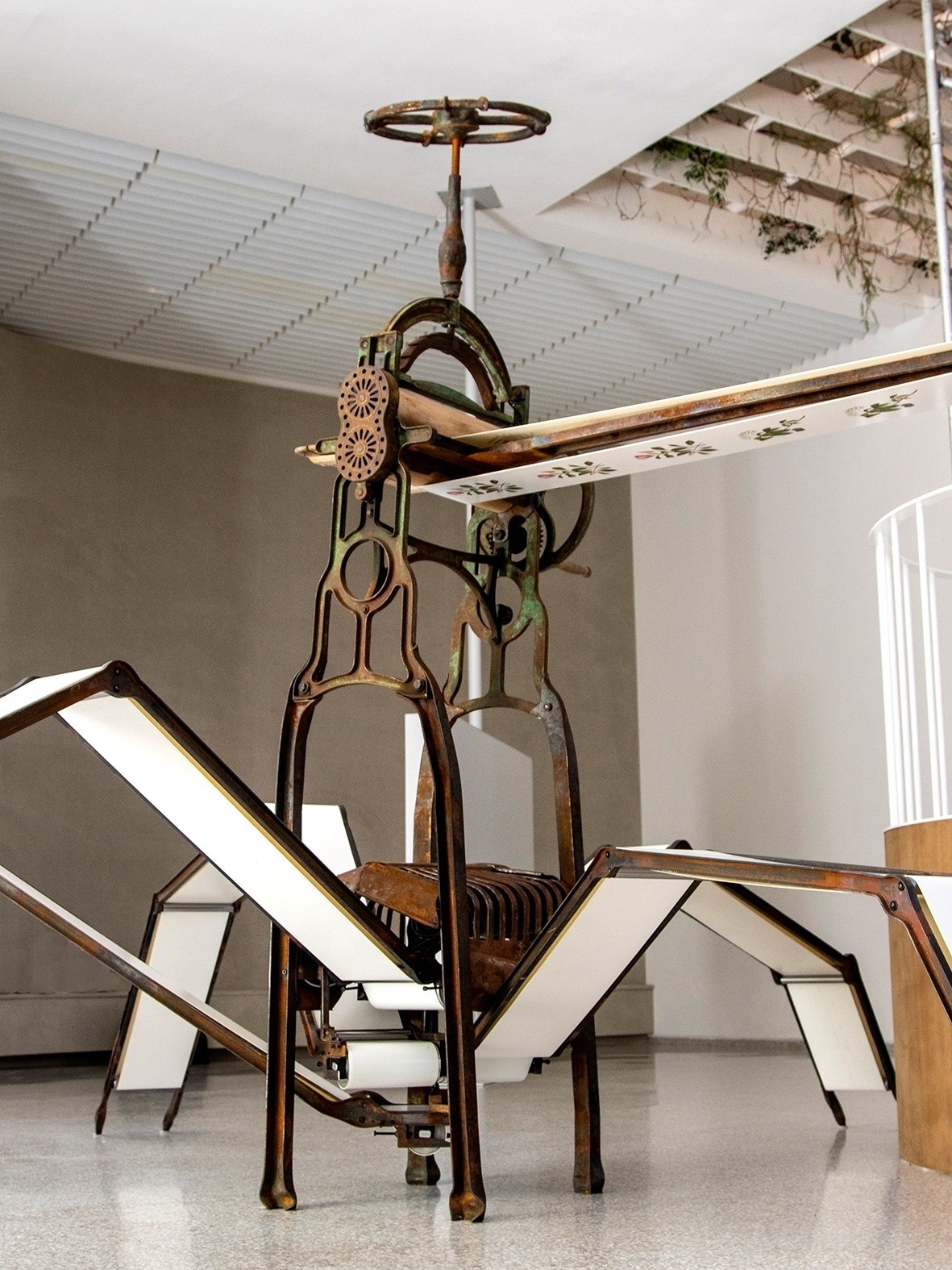Generously, the Netherlands lent the Rietveld Pavilion to Estonia for the Venice Biennale. But we could not prevent the work of one of our guests being censored. What does real engagement actually look like?
This article appeared in No. 43 of De Groene Amsterdammer, October 2022

Ever since the Mondriaan Fund announced that the Rietveld Pavilion was on loan to Estonia, I have been trying to resist the temptation to think that this was a pretentious idea. I feared that the Netherlands were merely giving another country the key to the pavilion and did not understand the complexity of that invitation. That the gesture is a playful marketing stunt that gives Dutch art extra visibility but does not change the prominent place we occupy as a country at the Venice Biennale.
The artists selected by the Estonian commission for the Rietveld Pavilion Kristina Norman and Bita Razavi also understood that something was at stake for the Netherlands. In their exhibition Orchidelirium: An Appetite for Abundance, they wanted to blur the boundaries between dominant and dominated countries. There was a grand opening, with a seemingly successful exhibition on Estonia, the Netherlands and Indonesia. But behind the scenes things were rumbling. Up until the opening of the biennial, Razavi worked on an artistic contribution that was eventually blurred from the public eye by the Estonian committee.
The walls of the Rietveld pavilion read, “A small nation, usually on the periphery, steps inside the Dutch pavilion (…). The Estonian team has not dared to choose the independent word ‘Rietveld Pavilion.’ Instead, the pavilion is referred to as a Dutch property where Estonia is a guest, and moreover, Estonia does not even mention itself by name. The other wall texts, writing about the work, are equally mysterious. As if it should not be said out loud that this exhibition focuses on the colonial past of the country that now grants Estonia a place on the main stage.
For Orchidelirium: An Appetite for Abundance, curator Corina L. Apostol sketched a story about nineteenth-century Estonian artist and world traveler Emilie Rosalie Saal. Together with her partner, writer, photographer and topographer Andres, Emilie Rosalie lived on Java, at the time part of the Dutch East Indies. Apostol used the Saals to show the complexity of designations as victims and perpetrators of colonialism. After all, the Saals came from Estonia, appropriated by the Russian Empire, and then settled in Indonesia, learning the language and culture, and painting flowers as a pastime. Botany was central to Emilie Rosalie’s drawings and now to this exhibition. The orchid, Andres described in his notes, was beyond the imagination of the people, and when the flower was in bloom, it made the newspapers. In the exhibition, then, this flower is a metaphor for something that thrilled the masses in other times, but which has now become so banal that one can also see its ugly sides. Only now, the ecological exploitation that preceded the success of the orchid as a houseplant is becoming visible.

Razavi in particular sought to show the eagerness by which land, people and animals were exploited at the time. She created Kratt: Diabolo No 3, a kinetic, electrically powered sculpture that stands in the middle of the pavilion. The sculpture is inspired by a mythological creature from Estonian folklore. According to the myth, Kratt will come to life when three drops of blood are sacrificed to the devil. After that, Kratt will perform any task, no matter how evil, at the behest of his master. The unscrupulous machine in the pavilion resembles a large spider with a machine belt. On the top band are the drawings of Emilie Rosalie. The mechanism that allows these drawings to be viewed refers to the invisible labor of Indonesian housekeepers in Saal’s artistry. Also, the sharp contrast between the white background and the botanical drawings is a deliberate choice: the white background of Saal’s work cut away the colonial environment, leaving behind a beautiful flower. But on the base of the machine, only a white background can be seen. It doesn’t look unfinished, and at most, as a visitor, you feel like you’ve overlooked something. But there, on those spider legs, something was rather not shown than shown.
Kratt’s legs should have featured archival images showing how Dutch colonial extraction of labor and land led to the depletion of landscapes and people in the Dutch East Indies. One of the pictures shows a white woman dressed in a white dress sitting amazons on a horse. Another image, on the contrary, shows workers, in the shadow of a makeshift canopy. The Dutch Fotomuseum, which owns the photos, determined that the copyright was time-barred. Still, the Estonian commission found it unethical for Razavi to use them in her work. The curator worried about cultural appropriation, but Razavi continued to defend the work, arguing, among other things, that the curator had sent the images to her herself. She recounts in a conversation over the phone how the director of the Estonian Centre for Contemporary Art, Maria Arusoo, ordered the production process of the archival images to be halted while she herself was hospitalized with stress symptoms. In an e-mail, Arusoo wrote her that this decision was made in consultation with the curator because Razavi did not respond to their inquiries. She later pledged that all works would still be produced as planned. If asked about them at the opening, Razavi was quite welcome to say that the prints were still missing, but she was not to use the word censorship, Razavi said. But despite the commitment, the prints never appeared in the Rietveld Pavilion. The organization of the Estonian Pavilion in Venice and the Estonian Center for Contemporary Art do not recognize the course of events described by Razavi.

It would be ironic to point out from the Netherlands why Razavi’s work was censored. We do, however, have to put the lease between Estonia and the Netherlands, especially in the Netherlands, under a magnifying glass. Quite some time ago, the director of the Estonian Centre for Contemporary Art received a phone call from the Mondriaan Fund, asking if Estonia wouldn’t like to borrow the Dutch pavilion in the heart of the Giardini for once. A press release also appeared at one point in the Netherlands with the headline “Radically different approach”. Radicality seems desirable because Venice’s biennial site, the Giardini, is frozen in time. No new pavilions have been allowed to be built for 25 years so a young country like Estonia has no chance at such a prominent position. In addition, the Mondriaan Fund believes that Estonia has an art scene not inferior to that of the Netherlands. But of course there are more countries without a pavilion with a rich art sector. There were more options, but the choice of Estonia was a private idea, decided internally, reaching the public as mere notification.
In retrospect, it now appears that a country was chosen where artistic freedom was curtailed, which is in stark contrast to the freedom the Dutch craved at this biennial. While the context of the Giardini is seen as a reflection of geopolitical power, this also makes it a rather boring place for experimental curatorship. So the Mondriaan Fund was also curious to know what freedoms are conceivable when the Netherlands seek the edges of the city. As if The Dutch are going camping with a fat wallet in their pocket, to challenge themselves. There is no need to survive, not as there is for countries that have had to claim their independence, or countries where independence is an unimaginable fantasy. This naivety works its way into the official communication surrounding the biennial: there seems to be no awareness of the labor and personal investment involved in occupying and liberating artistic space. As if no one could imagine that the clearing of space may not always take place in a building, but all the more can be found in the relationships we establish with each other.
Call it naive, or strategic, but no one reacted when Razavi’s work was censored without permission. Her dissatisfaction had to be conveyed to the public by the artist herself, and as a vulnerable individual, she had to bear the burden of a work that provoked, in a borrowed environment where anything was possible, but where exactly this statement was not allowed to be made.
From the moment Estonia accepted the invitation, the Mondriaan Fund wanted to keep its distance from what was happening in the pavilion. Probably in doing so it wanted to free up as much space as possible. But the downside of this liberal concept of space is that it almost turns the Dutch pavilion into a real estate object. With the Mondriaan Fund as the manager of the key box, distant and efficient, like the owner of a Venetian Airbnb never sees his guests in real life, and communication is limited to the question of whether everything is still in one piece when they leave.
Would it not have been sympathetic from the Mondriaan Fund to devote an article to Orchidelirium: An Appetite for Abundance? One could have seen the sharing of information about the Estonian exhibition as an extension of the lease, allowing Estonian artists to take advantage not only of white walls but also of the vast reach of the Netherlands. Instead, Dutch involvement in the Estonian presentation is minimal. And that is not just the Mondriaan Fund to blame. The challenge on the first international outing in ages is to find the church where melanie bonajo is showing, not to fathom the presentation in the Rietveld Pavilion. My friends also share colourful images, of parties celebrating various forms of freedom and lasciviousness, but what Razavi intended with An Appetite for Abundance has fallen on deaf ears with Dutch audiences.
The archival images missing from the pavilion are now on view as a traveling exhibition that began in Razavi’s hometown of Tehran. By taking more distance, the artist aims to break a pattern whereby European colonial history is told exclusively from a Eurocentric perspective. It is precisely this pain point that makes it complicated for the Dutch to talk about the Razavi incident. And we probably missed it en masse because it was so carefully disguised.
Of course it would have been interesting to discuss cultural appropriation in the Rietveld Pavilion. But at least as important is the question of how the Dutch art field could have really made space and engaged with the Estonian exhibition. Not because we control the key box, but because we allow ourselves to celebrate artistic freedom elsewhere.
The organization of the Estonian Pavilion in Venice and the Estonian Centre for Contemporary Art state that they do not recognize themselves in the course of events as described by Bita Razavi.

